warning light YAMAHA YZF-R6 2012 User Guide
[x] Cancel search | Manufacturer: YAMAHA, Model Year: 2012, Model line: YZF-R6, Model: YAMAHA YZF-R6 2012Pages: 112, PDF Size: 2.46 MB
Page 30 of 112
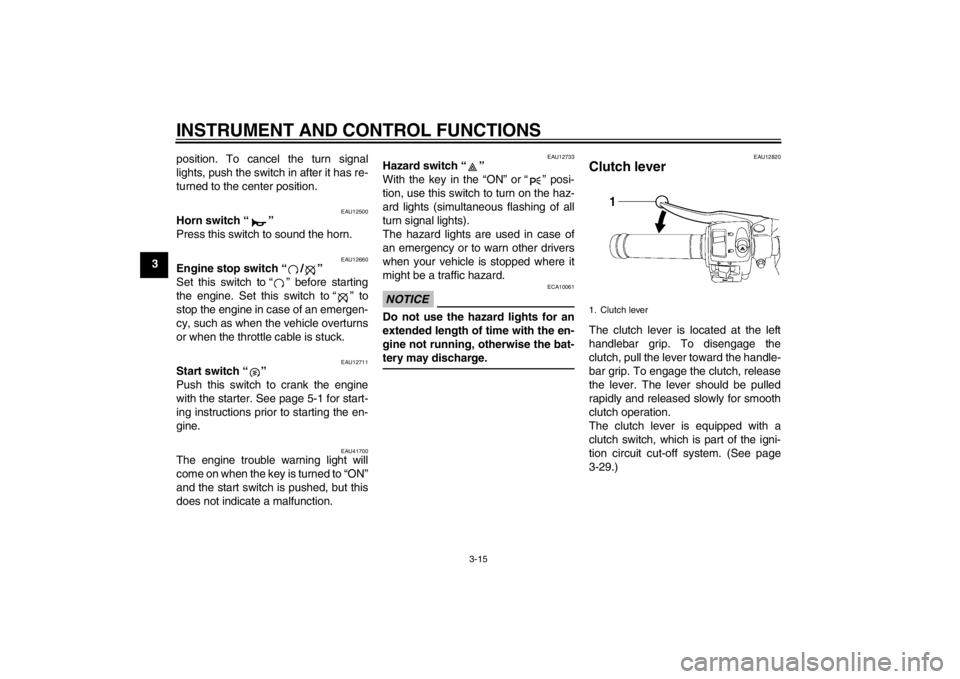
INSTRUMENT AND CONTROL FUNCTIONS
3-15
3position. To cancel the turn signal
lights, push the switch in after it has re-
turned to the center position.
EAU12500
Horn switch “ ”
Press this switch to sound the horn.
EAU12660
Engine stop switch “ / ”
Set this switch to “ ” before starting
the engine. Set this switch to “ ” to
stop the engine in case of an emergen-
cy, such as when the vehicle overturns
or when the throttle cable is stuck.
EAU12711
Start switch “ ”
Push this switch to crank the engine
with the starter. See page 5-1 for start-
ing instructions prior to starting the en-
gine.
EAU41700
The engine trouble warning light will
come on when the key is turned to “ON”
and the start switch is pushed, but this
does not indicate a malfunction.
EAU12733
Hazard switch “ ”
With the key in the “ON” or “ ” posi-
tion, use this switch to turn on the haz-
ard lights (simultaneous flashing of all
turn signal lights).
The hazard lights are used in case of
an emergency or to warn other drivers
when your vehicle is stopped where it
might be a traffic hazard.NOTICE
ECA10061
Do not use the hazard lights for an
extended length of time with the en-
gine not running, otherwise the bat-
tery may discharge.
EAU12820
Clutch lever The clutch lever is located at the left
handlebar grip. To disengage the
clutch, pull the lever toward the handle-
bar grip. To engage the clutch, release
the lever. The lever should be pulled
rapidly and released slowly for smooth
clutch operation.
The clutch lever is equipped with a
clutch switch, which is part of the igni-
tion circuit cut-off system. (See page
3-29.)1. Clutch lever
U1JSE0E0.book Page 15 Wednesday, July 27, 2011 10:34 AM
Page 33 of 112
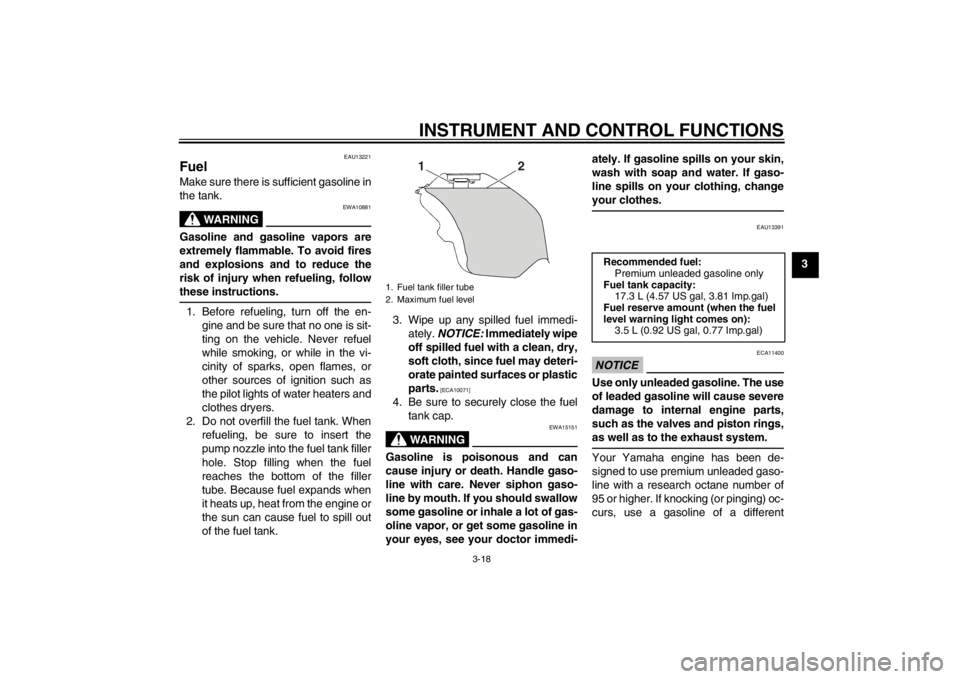
INSTRUMENT AND CONTROL FUNCTIONS
3-18
3
EAU13221
Fuel Make sure there is sufficient gasoline in
the tank.
WARNING
EWA10881
Gasoline and gasoline vapors are
extremely flammable. To avoid fires
and explosions and to reduce the
risk of injury when refueling, follow
these instructions.1. Before refueling, turn off the en-gine and be sure that no one is sit-
ting on the vehicle. Never refuel
while smoking, or while in the vi-
cinity of sparks, open flames, or
other sources of ignition such as
the pilot lights of water heaters and
clothes dryers.
2. Do not overfill the fuel tank. When refueling, be sure to insert the
pump nozzle into the fuel tank filler
hole. Stop filling when the fuel
reaches the bottom of the filler
tube. Because fuel expands when
it heats up, heat from the engine or
the sun can cause fuel to spill out
of the fuel tank. 3. Wipe up any spilled fuel immedi-
ately. NOTICE: Immediately wipe
off spilled fuel with a clean, dry,
soft cloth, since fuel may deteri-
orate painted surfaces or plastic
parts.
[ECA10071]
4. Be sure to securely close the fuel tank cap.
WARNING
EWA15151
Gasoline is poisonous and can
cause injury or death. Handle gaso-
line with care. Never siphon gaso-
line by mouth. If you should swallow
some gasoline or inhale a lot of gas-
oline vapor, or get some gasoline in
your eyes, see your doctor immedi- ately. If gasoline spills on your skin,
wash with soap and water. If gaso-
line spills on your clothing, change
your clothes.
EAU13391
NOTICE
ECA11400
Use only unleaded gasoline. The use
of leaded gasoline will cause severe
damage to internal engine parts,
such as the valves and piston rings,
as well as to the exhaust system.Your Yamaha engine has been de-
signed to use premium unleaded gaso-
line with a research octane number of
95 or higher. If knocking (or pinging) oc-
curs, use a gasoline of a different
1. Fuel tank filler tube
2. Maximum fuel level
2
1
Recommended fuel:
Premium unleaded gasoline only
Fuel tank capacity: 17.3 L (4.57 US gal, 3.81 Imp.gal)
Fuel reserve amount (when the fuel
level warning light comes on): 3.5 L (0.92 US gal, 0.77 Imp.gal)
U1JSE0E0.book Page 18 Wednesday, July 27, 2011 10:34 AM
Page 49 of 112
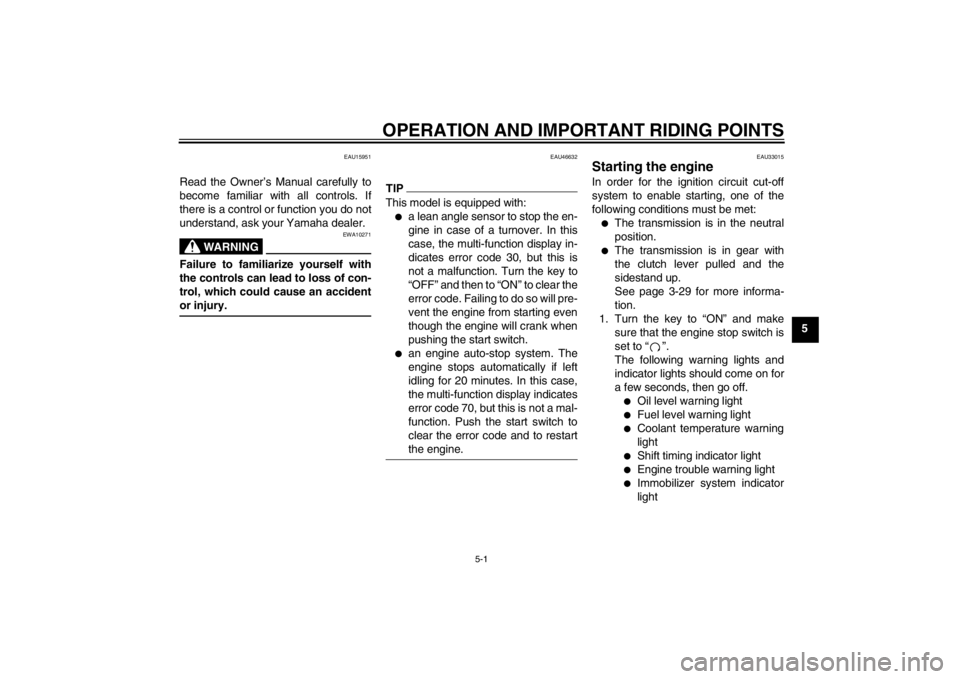
OPERATION AND IMPORTANT RIDING POINTS
5-1
5
EAU15951
Read the Owner’s Manual carefully to
become familiar with all controls. If
there is a control or function you do not
understand, ask your Yamaha dealer.
WARNING
EWA10271
Failure to familiarize yourself with
the controls can lead to loss of con-
trol, which could cause an accident
or injury.
EAU46632
TIPThis model is equipped with:●
a lean angle sensor to stop the en-
gine in case of a turnover. In this
case, the multi-function display in-
dicates error code 30, but this is
not a malfunction. Turn the key to
“OFF” and then to “ON” to clear the
error code. Failing to do so will pre-
vent the engine from starting even
though the engine will crank when
pushing the start switch.
●
an engine auto-stop system. The
engine stops automatically if left
idling for 20 minutes. In this case,
the multi-function display indicates
error code 70, but this is not a mal-
function. Push the start switch to
clear the error code and to restart
the engine.
EAU33015
Starting the engine In order for the ignition circuit cut-off
system to enable starting, one of the
following conditions must be met:●
The transmission is in the neutral
position.
●
The transmission is in gear with
the clutch lever pulled and the
sidestand up.
See page 3-29 for more informa-
tion.
1. Turn the key to “ON” and make sure that the engine stop switch is
set to “ ”.
The following warning lights and
indicator lights should come on for
a few seconds, then go off.●
Oil level warning light
●
Fuel level warning light
●
Coolant temperature warning
light
●
Shift timing indicator light
●
Engine trouble warning light
●
Immobilizer system indicator
light
U1JSE0E0.book Page 1 Wednesday, July 27, 2011 10:34 AM
Page 50 of 112
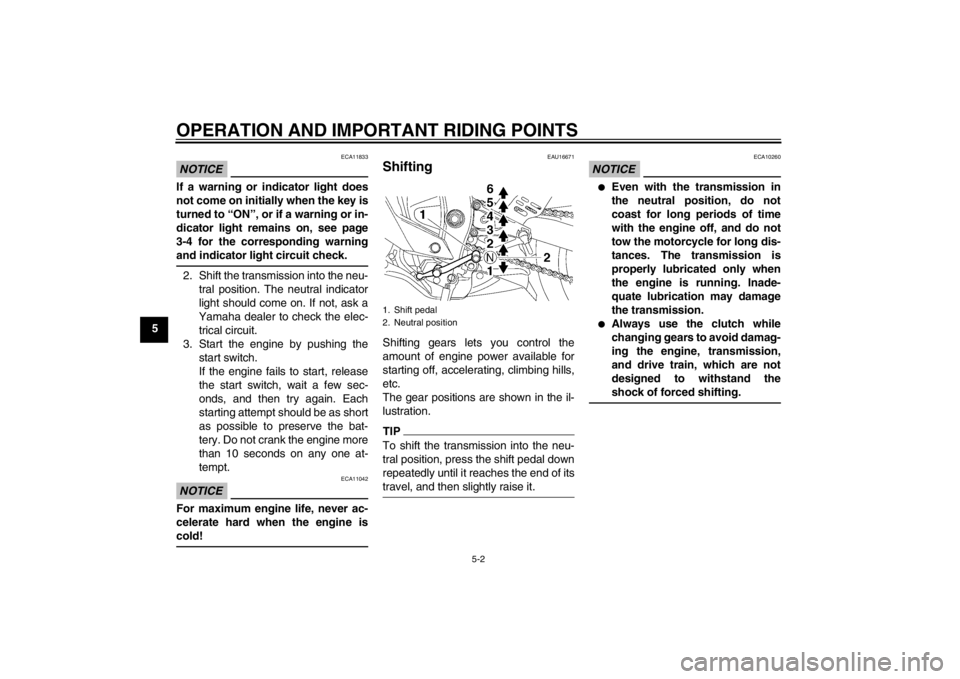
OPERATION AND IMPORTANT RIDING POINTS
5-2
5
NOTICE
ECA11833
If a warning or indicator light does
not come on initially when the key is
turned to “ON”, or if a warning or in-
dicator light remains on, see page
3-4 for the corresponding warning
and indicator light circuit check.2. Shift the transmission into the neu-tral position. The neutral indicator
light should come on. If not, ask a
Yamaha dealer to check the elec-
trical circuit.
3. Start the engine by pushing the start switch.
If the engine fails to start, release
the start switch, wait a few sec-
onds, and then try again. Each
starting attempt should be as short
as possible to preserve the bat-
tery. Do not crank the engine more
than 10 seconds on any one at-
tempt.NOTICE
ECA11042
For maximum engine life, never ac-
celerate hard when the engine is
cold!
EAU16671
Shifting Shifting gears lets you control the
amount of engine power available for
starting off, accelerating, climbing hills,
etc.
The gear positions are shown in the il-
lustration.TIPTo shift the transmission into the neu-
tral position, press the shift pedal down
repeatedly until it reaches the end of its
travel, and then slightly raise it.
NOTICE
ECA10260
●
Even with the transmission in
the neutral position, do not
coast for long periods of time
with the engine off, and do not
tow the motorcycle for long dis-
tances. The transmission is
properly lubricated only when
the engine is running. Inade-
quate lubrication may damage
the transmission.
●
Always use the clutch while
changing gears to avoid damag-
ing the engine, transmission,
and drive train, which are not
designed to withstand the
shock of forced shifting.
1. Shift pedal
2. Neutral position
U1JSE0E0.book Page 2 Wednesday, July 27, 2011 10:34 AM
Page 68 of 112
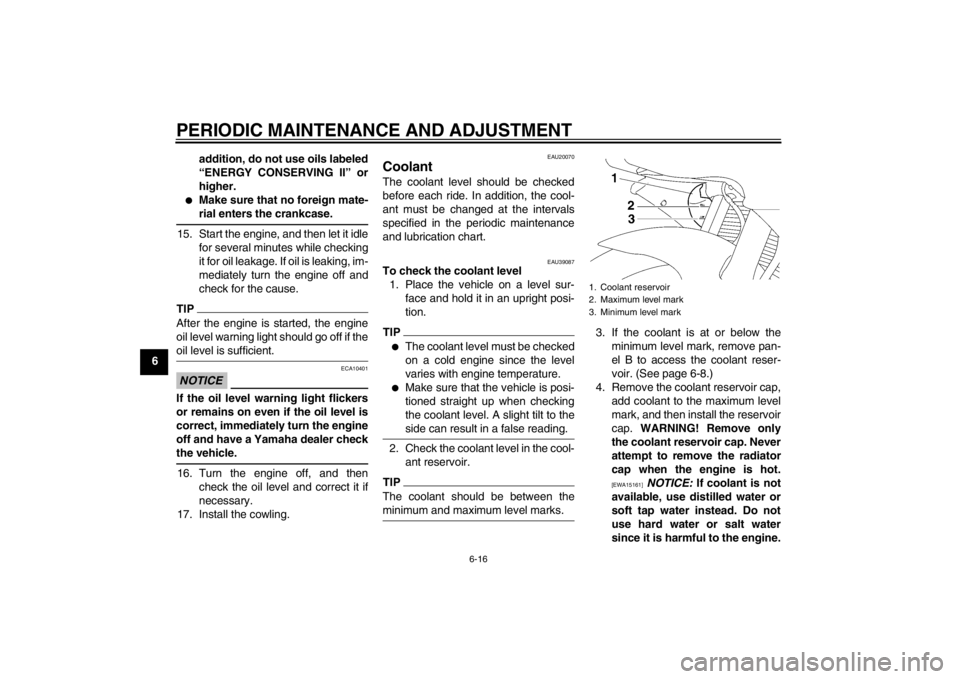
PERIODIC MAINTENANCE AND ADJUSTMENT
6-16
6addition, do not use oils labeled
“ENERGY CONSERVING II” or
higher.
●
Make sure that no foreign mate-
rial enters the crankcase.
15. Start the engine, and then let it idle
for several minutes while checking
it for oil leakage. If oil is leaking, im-
mediately turn the engine off and
check for the cause.TIPAfter the engine is started, the engine
oil level warning light should go off if the
oil level is sufficient.NOTICE
ECA10401
If the oil level warning light flickers
or remains on even if the oil level is
correct, immediately turn the engine
off and have a Yamaha dealer check
the vehicle.16. Turn the engine off, and thencheck the oil level and correct it if
necessary.
17. Install the cowling.
EAU20070
Coolant The coolant level should be checked
before each ride. In addition, the cool-
ant must be changed at the intervals
specified in the periodic maintenance
and lubrication chart.
EAU39087
To check the coolant level 1. Place the vehicle on a level sur- face and hold it in an upright posi-
tion.TIP●
The coolant level must be checked
on a cold engine since the level
varies with engine temperature.
●
Make sure that the vehicle is posi-
tioned straight up when checking
the coolant level. A slight tilt to the
side can result in a false reading.
2. Check the coolant level in the cool-ant reservoir.TIPThe coolant should be between the
minimum and maximum level marks.
3. If the coolant is at or below theminimum level mark, remove pan-
el B to access the coolant reser-
voir. (See page 6-8.)
4. Remove the coolant reservoir cap, add coolant to the maximum level
mark, and then install the reservoir
cap. WARNING! Remove only
the coolant reservoir cap. Never
attempt to remove the radiator
cap when the engine is hot.
[EWA15161]
NOTICE: If coolant is not
available, use distilled water or
soft tap water instead. Do not
use hard water or salt water
since it is harmful to the engine.
1. Coolant reservoir
2. Maximum level mark
3. Minimum level mark
U1JSE0E0.book Page 16 Wednesday, July 27, 2011 10:34 AM
Page 87 of 112
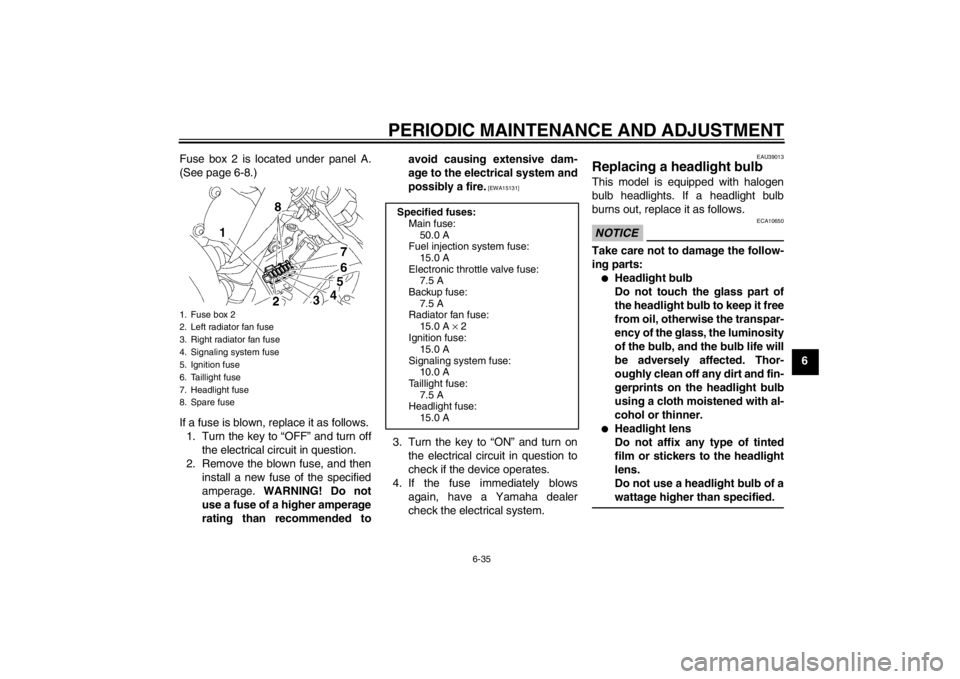
PERIODIC MAINTENANCE AND ADJUSTMENT
6-35
6
Fuse box 2 is located under panel A.
(See page 6-8.)
If a fuse is blown, replace it as follows.
1. Turn the key to “OFF” and turn off the electrical circuit in question.
2. Remove the blown fuse, and then install a new fuse of the specified
amperage. WARNING! Do not
use a fuse of a higher amperage
rating than recommended to avoid causing extensive dam-
age to the electrical system and
possibly a fire.
[EWA15131]
3. Turn the key to “ON” and turn on
the electrical circuit in question to
check if the device operates.
4. If the fuse immediately blows again, have a Yamaha dealer
check the electrical system.
EAU39013
Replacing a he adlight bulb This model is equipped with halogen
bulb headlights. If a headlight bulb
burns out, replace it as follows.NOTICE
ECA10650
Take care not to damage the follow-
ing parts:●
Headlight bulb
Do not touch the glass part of
the headlight bulb to keep it free
from oil, otherwise the transpar-
ency of the glass, the luminosity
of the bulb, and the bulb life will
be adversely affected. Thor-
oughly clean off any dirt and fin-
gerprints on the headlight bulb
using a cloth moistened with al-
cohol or thinner.
●
Headlight lens
Do not affix any type of tinted
film or stickers to the headlight
lens.
Do not use a headlight bulb of a
wattage higher than specified.
1. Fuse box 2
2. Left radiator fan fuse
3. Right radiator fan fuse
4. Signaling system fuse
5. Ignition fuse
6. Taillight fuse
7. Headlight fuse
8. Spare fuse
Specified fuses:
Main fuse:50.0 A
Fuel injection system fuse:
15.0 A
Electronic throttle valve fuse: 7.5 A
Backup fuse: 7.5 A
Radiator fan fuse:
15.0 A × 2
Ignition fuse: 15.0 A
Signaling system fuse: 10.0 A
Taillight fuse:
7.5 A
Headlight fuse: 15.0 A
U1JSE0E0.book Page 35 Wednesday, July 27, 2011 10:34 AM
Page 95 of 112
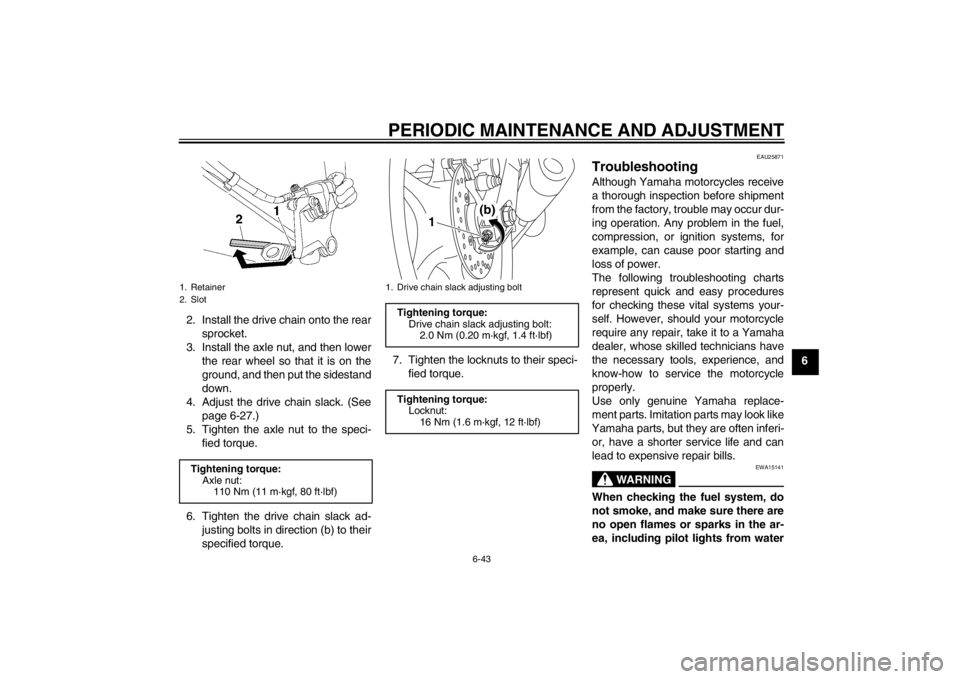
PERIODIC MAINTENANCE AND ADJUSTMENT
6-43
6
2. Install the drive chain onto the rear
sprocket.
3. Install the axle nut, and then lower the rear wheel so that it is on the
ground, and then put the sidestand
down.
4. Adjust the drive chain slack. (See page 6-27.)
5. Tighten the axle nut to the speci- fied torque.
6. Tighten the drive chain slack ad- justing bolts in direction (b) to their
specified torque. 7. Tighten the locknuts to their speci-
fied torque.
EAU25871
Troubleshooting Although Yamaha motorcycles receive
a thorough inspection before shipment
from the factory, trouble may occur dur-
ing operation. Any problem in the fuel,
compression, or ignition systems, for
example, can cause poor starting and
loss of power.
The following troubleshooting charts
represent quick and easy procedures
for checking these vital systems your-
self. However, should your motorcycle
require any repair, take it to a Yamaha
dealer, whose skilled technicians have
the necessary tools, experience, and
know-how to service the motorcycle
properly.
Use only genuine Yamaha replace-
ment parts. Imitation parts may look like
Yamaha parts, but they are often inferi-
or, have a shorter service life and can
lead to expensive repair bills.
WARNING
EWA15141
When checking the fuel system, do
not smoke, and make sure there are
no open flames or sparks in the ar-
ea, including pilot lights from water
1. Retainer
2. SlotTightening torque:Axle nut:110 Nm (11 m·kgf, 80 ft·lbf)
1. Drive chain slack adjusting bolt
Tightening torque: Drive chain slack adjusting bolt:2.0 Nm (0.20 m·kgf, 1.4 ft·lbf)
Tightening torque: Locknut:
16 Nm (1.6 m·kgf, 12 ft·lbf)
(b)
1
U1JSE0E0.book Page 43 Wednesday, July 27, 2011 10:34 AM
Page 101 of 112
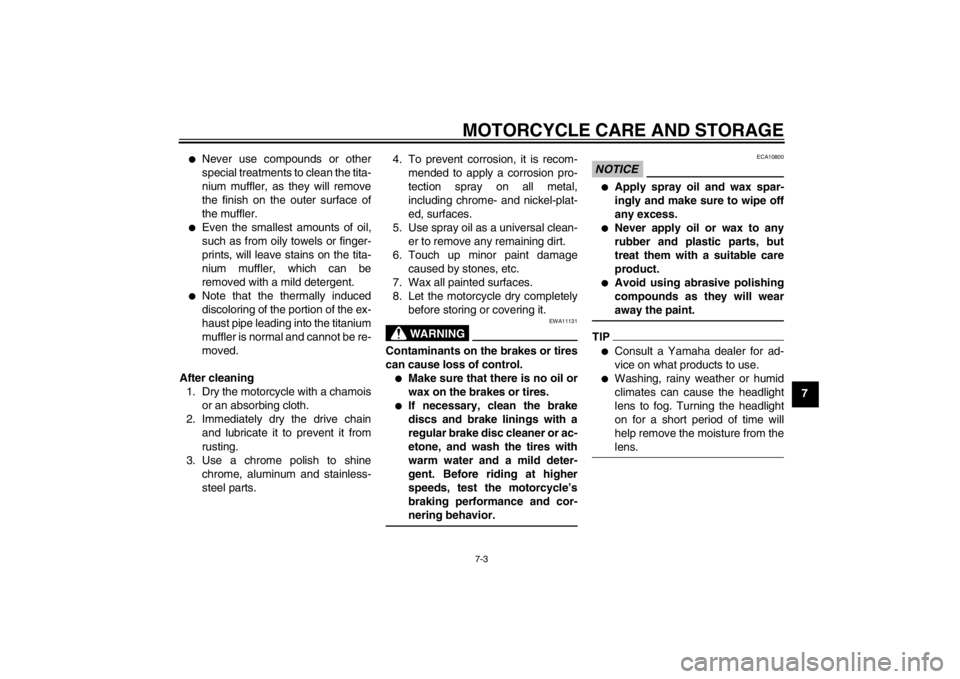
MOTORCYCLE CARE AND STORAGE
7-3
7
●
Never use compounds or other
special treatments to clean the tita-
nium muffler, as they will remove
the finish on the outer surface of
the muffler.
●
Even the smallest amounts of oil,
such as from oily towels or finger-
prints, will leave stains on the tita-
nium muffler, which can be
removed with a mild detergent.
●
Note that the thermally induced
discoloring of the portion of the ex-
haust pipe leading into the titanium
muffler is normal and cannot be re-
moved.
After cleaning 1. Dry the motorcycle with a chamois or an absorbing cloth.
2. Immediately dry the drive chain and lubricate it to prevent it from
rusting.
3. Use a chrome polish to shine chrome, aluminum and stainless-
steel parts. 4. To prevent corrosion, it is recom-
mended to apply a corrosion pro-
tection spray on all metal,
including chrome- and nickel-plat-
ed, surfaces.
5. Use spray oil as a universal clean- er to remove any remaining dirt.
6. Touch up minor paint damage caused by stones, etc.
7. Wax all painted surfaces.
8. Let the motorcycle dry completely before storing or covering it.
WARNING
EWA11131
Contaminants on the brakes or tires
can cause loss of control.●
Make sure that there is no oil or
wax on the brakes or tires.
●
If necessary, clean the brake
discs and brake linings with a
regular brake disc cleaner or ac-
etone, and wash the tires with
warm water and a mild deter-
gent. Before riding at higher
speeds, test the motorcycle’s
braking performance and cor-
nering behavior.
NOTICE
ECA10800
●
Apply spray oil and wax spar-
ingly and make sure to wipe off
any excess.
●
Never apply oil or wax to any
rubber and plastic parts, but
treat them with a suitable care
product.
●
Avoid using abrasive polishing
compounds as they will wear
away the paint.
TIP●
Consult a Yamaha dealer for ad-
vice on what products to use.
●
Washing, rainy weather or humid
climates can cause the headlight
lens to fog. Turning the headlight
on for a short period of time will
help remove the moisture from the
lens.
U1JSE0E0.book Page 3 Wednesday, July 27, 2011 10:34 AM
Page 106 of 112

SPECIFICATIONS
8-3
8
Charging system:AC magnetoBattery:Model:
YTZ10S
Voltage, capacity: 12 V, 8.6 AhHeadlight:Bulb type:
Halogen bulbBulb voltage, wattage × quantity:Headlight:
12 V, 55 W × 2
Tail/brake light:
LED
Front turn signal light: 12 V, 10.0 W × 2
Rear turn signal light: 12 V, 10.0 W × 2
Auxiliary light:
LED
License plate light: 12 V, 5.0 W × 1
Meter lighting: LED
Neutral indicator light:
LED
High beam indicator light: LED
Oil level warning light: LED
Turn signal indicator light:
LED Fuel level warning light:
LED
Coolant temperature warning light: LED
Engine trouble warning light:
LED
Immobilizer system indicator light: LED
Shift timing indicator light: LED
Fuses:Main fuse:50.0 A
Headlight fuse: 15.0 A
Taillight fuse:
7.5 A
Signaling system fuse: 10.0 A
Ignition fuse: 15.0 A
Radiator fan fuse:
15.0 A × 2
Fuel injection system fuse: 15.0 A
Backup fuse: 7.5 A
Electronic throttle valve fuse:
7.5 A
U1JSE0E0.book Page 3 Wednesday, July 27, 2011 10:34 AM
Page 108 of 112

INDEXAAir filter element .................................... 6-19
Anti-theft alarm (optional)...................... 3-14
Auxiliary light ......................................... 6-38BBattery................................................... 6-33
Brake and clutch levers, checking and lubricating ..................... 6-30
Brake and shift pedals,
checking and lubricating ..................... 6-30
Brake fluid, changing ............................ 6-26
Brake fluid level, checking .................... 6-25
Brake lever ............................................ 3-16
Brake lever free play, checking ............. 6-23
Brake light switches .............................. 6-24
Brake pedal ........................................... 3-17CCables, checking and lubricating .......... 6-29
Care ........................................................ 7-1
Catalytic converters .............................. 3-19
Clutch lever ........................................... 3-15
Clutch lever free play, adjusting ............ 6-23
Coolant.................................................. 6-16
Coolant temperature warning light .......... 3-5
Cowlings and panels, removing and installing ......................... 6-8DDimmer switch ...................................... 3-14
Drive chain, cleaning and lubricating .... 6-28
Drive chain slack ................................... 6-27EEngine break-in ....................................... 5-3
Engine idling speed, checking .............. 6-19
Engine oil and oil filter cartridge ............ 6-13 Engine stop switch................................ 3-15
Engine trouble warning light ................... 3-7
EXUP system ....................................... 3-28
FFront and rear brake pads, checking .... 6-24
Front fork, adjusting .............................. 3-22
Front fork, checking .............................. 6-32
Fuel....................................................... 3-18
Fuel consumption, tips for reducing........ 5-3
Fuel level warning light ........................... 3-4
Fuel tank breather hose and
overflow hose ..................................... 3-19
Fuel tank cap ........................................ 3-17
Fuses, replacing ................................... 6-34HHandlebar switches .............................. 3-14
Hazard switch ....................................... 3-15
Headlight bulb, replacing ...................... 6-35
Helmet holding cable ............................ 3-21
High beam indicator light ........................ 3-4
Horn switch ........................................... 3-15IIdentification numbers ............................ 9-1
Ignition circuit cut-off system ................ 3-29
Immobilizer system ................................. 3-1
Immobilizer system indicator light........... 3-7
Indicator lights and warning lights .......... 3-4LLicense plate light bulb, replacing ........ 6-38
Luggage strap holders .......................... 3-27MMain switch/steering lock........................ 3-2
Maintenance and lubrication, periodic .... 6-4 Maintenance,
emission control system ....................... 6-3
Matte color, caution ................................. 7-1
Model label .............................................. 9-1
Multi-function meter unit .......................... 3-8
NNeutral indicator light .............................. 3-4OOil level warning light .............................. 3-4PParking .................................................... 5-4
Part locations .......................................... 2-1
Pass switch ........................................... 3-14RRear view mirrors .................................. 3-22SSafety information ................................... 1-1
Seats ..................................................... 3-20
Shifting .................................................... 5-2
Shift pedal ............................................. 3-16
Shift timing indicator light ........................ 3-7
Shock absorber assembly, adjusting .... 3-25
Sidestand .............................................. 3-28
Sidestand, checking and lubricating...... 6-31
Spark plugs, checking ........................... 6-12
Specifications .......................................... 8-1
Starting the engine .................................. 5-1
Start switch............................................ 3-15
Steering, checking................................. 6-32
Storage.................................................... 7-4
Supporting the motorcycle .................... 6-39
Swingarm pivots, lubricating ................. 6-31TTail/brake light ....................................... 6-37
U1JSE0E0.book Page 1 Wednesday, July 27, 2011 10:34 AM